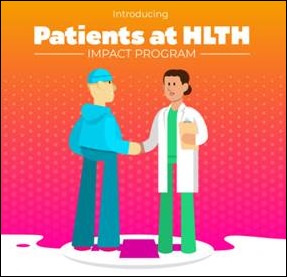Really interesting perspective — especially around the EHR market. What I’m seeing lines up with this: Epic keeps consolidating, Oracle/Cerner…
EPtalk by Dr. Jayne 11/10/22
I’m glad to see healthcare delivery organizations putting their proverbial feet down when it comes to patients treating staff poorly. Mass General Brigham is one of the more visible examples, as they release their patient code of conduct. The policy has zero tolerance for “words or actions that are disrespectful, racist, discriminatory, hostile, or harassing.” Patients can be asked to seek future non-emergency care elsewhere if they are found to exhibit a list of behaviors, including sexual or vulgar words or actions. Disrupting another patient’s care or experience is also on the list. Patients who violate the code will be asked to explain their point of view prior to decisions being made about future care at the institution.

Next week’s HLTH conference will include the “Patients at HLTH Impact Program,” which has been designed so that patients and patient advocates can be engaged as “equal partners in care design.” The track offers opportunities for health tech leaders to interact with patients. Since nearly every employee of every organization in the US has been a patient at some point in their lives, I’d suggest that execs don’t need to go far or to spend money on conferences to get input. One of the panels being offered is around “What do digitally-savvy, empowered consumers want?” and although that is certainly valuable, we need to not overlook the non-digitally savvy and non-empowered patients who might need our help even more than the other group. I’d like to see health tech execs troll the waiting rooms and cafeterias of any hospital in the US. They would certainly get an earful, and it would be cheaper than a trip to Las Vegas.
Addressing physician burnout is always a hot topic, so I was interested to see this piece from the American Medical Association on helping physicians reduce “pajama time” and have “more great days.” For those who might not have heard the term, pajama time refers to the time that physicians (and sometimes other clinicians) spend working outside of normal working hours. Although a lot of people think this phenomenon started when EHRs became more common, it definitely happened in the paper world. In my early days as a physician, I had a couple of colleagues who were constantly being reprimanded for taking charts home and sometimes forgetting to return them to the office. However, I was disappointed to see the suggestions made in the article. They’re not at all revolutionary:
- For medication refills, a recommendation was made to renew maintenance medications at the annual visit and to provide the maximum number of refills. This was standard of care in family medicine in the 1990s and appears several times in the literature, yet physicians still can’t incorporate it into their practices. I heard the best description of this workflow at CHIME this week, when UCHealth CMIO CT Lin referred to it as “90 by 4, don’t bother me no more” meaning that patients should receive 90-day prescriptions for their medications with four refills, enough to get them through their next annual appointment. It doesn’t apply to just primary care — anyone performing chronic care can do this and EHR preference lists or favorites make it easy.
- A physician was frustrated by having to walk to the printer to grab after visit summaries to hand to patients, so they installed printers in each exam room. Why are these not being sent through a patient portal for those who have accounts, so that they can become enduring materials accessible to the patient forever versus a piece of paper that can be lost? If the patient isn’t enrolled in a patient portal, why not have a medical assistant or checkout person print them?
I’ve spent a good portion of my professional life helping organizations address policy and procedure issues. Sometimes it’s a gap and new policies and procedures are needed, while other times there are changes needed to keep up with advances in EHR use, medical group governance, office practices, and more. Policies can be a blessing or a curse depending on what they contain, and the latter is addressed in a recent piece in JAMA Health Forum. The authors address the idea of harmful hospital policies and propose that they should be classified along with other “Never Events” such as wrong-side surgery. The authors list five particularly harmful policies:
- Aggressively pursuing payment from patients who are unable to afford their medical bills.
- Spending less on community benefits, such as public health or indigent care, than what is earned through tax breaks due to non-profit status.
- Noncompliance with federal requirements to be transparent about cost of care,
- Paying employees less than a living wage.
- Delivering racially segregated medical care by underserving surrounding communities of color.
They note that other entities, such as insurance companies and medical device makers, are also responsible for harms, but find that given the fact that the majority of hospitals exhibit at least one of the above behaviors, that hospital-associated harms should be addressed in a priority fashion. In addition to calling on hospital leaders to address them directly, they call on the Centers for Medicare and Medicaid Services to deny payments to hospitals engaged in these practices. They also call on state legislatures to require reporting in these areas and state attorneys general to investigate hospitals that are taking advantage of their non-profit status. The article is a quick read and should be mandatory for leaders of healthcare organizations.
Michigan Medicine has fallen victim to a phishing scheme that may have compromised the information of 33,000 patients. The health system learned of the attacks in August, but some patients didn’t receive the breach notification until more than two months later. At least four employees provided credentials that allowed hackers to access their email accounts. I feel for the employees who apparently disregarded their cybersecurity training, for the IT teams that had to investigate and work on the cleanup, and of course for the patients whose information was compromised by individuals who can’t follow the rules.
I feel like I’m fighting a battle on two fronts with email volume right now. At work, I’m getting multiple daily emails from HLTH which don’t always go to their designated folder since I was forced to take a recent Outlook update. In my personal email, I’m inundated with pre-Black Friday emails from retailers. I guess now that the Christmas shopping season actually begins before Halloween, it makes sense for Black Friday to begin November 1. I’d love to see the data on how various retail trends have changed over the years and see what the migration of the start dates for shopping seasons looks like. I’m sure there are big data folks in retail and marketing, so if someone has a connection to the data, maybe you can hook a girl up.
What do you think about the increasingly early start for holiday shopping? Leave a comment or email me.

Email Dr. Jayne.


You always have great posts, and this one ranks in the top five all time. I love this specifically: “I’d like to see health tech execs troll the waiting rooms and cafeterias of any hospital in the US. They would certainly get an earful, and it would be cheaper than a trip to Las Vegas.” I haven’t walked the halls of hospitals for going on 12 years now. I’m constantly paranoid of becoming one of those vendors who doesn’t have a clue about what’s going on in the trenches. Your posts help keep me slightly less paranoid. You keep me informed and grounded.